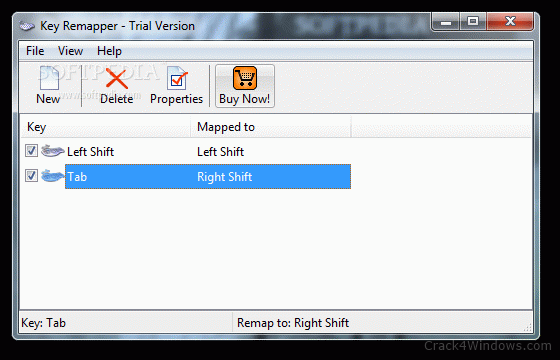Aug 21st 2015
Key Remapper 1.1 Crack + Serial Key Download 2024

Download Key Remapper
-
第一计算机输入方法是键盘、鼠标后不久,在其路径。 尽管趋势是慢慢地走向触功能的设备和其他方法,键盘是仍然要有一段时间了。 就像每个物体,它也可能发生故障或者有些钥匙拒绝工作,这是关键再映射是一定要派上用场。
当的应用程序开始直接将其隐藏在盘系统,但有一个弹出气囊消息,让你知道它的存在,所以你不会刮伤你的头上。 即使这样,你仍然依靠的主要窗口,为每一次操作,因为托盘图标不配有任何其他选择,除了关闭和自定义。
应用程序的核心功能是让你改变的功能的每一个按钮在键盘上别的东西。 整个过程很简单和直观的,并且你甚至可以配置破键,因为这样做是通过选择按钮从名单。
你不会看到任何实例,但是没有困难地试图在它自己。 快捷方式需要创建的,他们仍然在主要的窗口以及有哪些关键替换他们,以及是否重新活跃。 列表中可以排序根据的状态,最初的关键,以及一个就是映射。
默认情况下,应用程序的自动运行的上启动,这是一个整洁的优势。 更重要的是,名单的钥匙你可以重复盖了替代国家,以及媒体的按钮特别键盘。 当重的一个关键,你还有可能简单地禁止它。
可悲的是,需要使用主要的窗口,每次你想添加一个不同的快捷方式或甚至打开状态的一个现有的。 他们没有显示在托盘图标,也没有一个快捷方式至少切换他们所有。 更重要的是,你是限于一个单一的档案,和就已经很好看多个插槽不同的配套。
底线是关键再映射器不会带来任何新的东西,但提出了的想法在一个直观的环境,可以访问所有级别的经验。 虽然反复的国家不能通过盘图标,有没有办法创造更多的概况,该应用程序可以让你用几乎任何按钮在各种各样的键盘,并立即适用于你的喜好。
-
पहला कंप्यूटर इनपुट विधि कीबोर्ड, माउस के साथ शीघ्र ही बाद में अपने रास्ते. हालांकि प्रवृत्ति धीरे-धीरे की दिशा में आगे बढ़ स्पर्श-सक्षम उपकरणों और अन्य तरीकों, कीबोर्ड अभी भी चारों ओर हो रहा है । बस की तरह हर वस्तु के लिए, यह भी खराबी या कुछ चाबियाँ काम करने से मना, और इस है, जहां कुंजी Remapper है सुनिश्चित करने के लिए काम में आते हैं ।
आवेदन शुरू होता है जब यह सीधे छुपाता सिस्टम ट्रे में है, लेकिन वहाँ एक गुब्बारा पॉपअप संदेश देता है कि आपको पता है कि यह वहाँ अंत नहीं है तो आप ऊपर अपने सिर scratching है । तो भी, आप अभी भी गिनती पर मुख्य विंडो, हर ऑपरेशन के लिए है, क्योंकि ट्रे आइकन नहीं है फिट के साथ किसी भी अन्य विकल्प के अलावा, बंद करने के लिए और अनुकूलित.
आवेदन के मुख्य समारोह के लिए आप की कार्यक्षमता को बदलने के लिए हर बटन के लिए अपने कीबोर्ड पर कुछ और. पूरी प्रक्रिया बहुत आसान है और सहज ज्ञान युक्त, और आप भी कर सकते हैं कॉन्फ़िगर टूट चाबियाँ, क्योंकि यह किया जाता है का चयन करके बटन सूची में से एक है ।
आप नहीं मिलता है देखने के लिए किसी भी उदाहरण हैं, लेकिन वहाँ कोई कठिनाई नहीं है इसे बाहर की कोशिश में अपने आप को. शॉर्टकट की जरूरत बनाया जा करने के लिए, और वे में रहते हैं मुख्य विंडो पर विवरण के साथ, कुंजी क्या वे की जगह है, और चाहे या नहीं remap सक्रिय है । सूची हल किया जा सकता है के अनुसार, राज्य प्रारंभिक कुंजी है, के रूप में अच्छी तरह से एक के रूप में यह करने के लिए मैप किया.
डिफ़ॉल्ट रूप से, आवेदन स्वचालित रूप से स्टार्टअप पर चलाता है, जो एक साफ लाभ के लिए है । क्या अधिक है, की सूची चाबियाँ आप कर सकते हैं remap कवर वैकल्पिक अमेरिका, के रूप में अच्छी तरह के रूप में मीडिया बटन के लिए विशेष कीबोर्ड है । जब remapping के लिए एक कुंजी के साथ, आप भी संभावना है करने के लिए बस इसे अक्षम.
अफसोस की बात है, तो आप की जरूरत का उपयोग करने के लिए मुख्य विंडो में प्रत्येक समय आप चाहते हैं जोड़ने के लिए एक अलग शॉर्टकट या यहां तक कि राज्य टॉगल के एक मौजूदा एक. वे नहीं कर रहे हैं दिखाया ट्रे में आइकन, और न ही है वहाँ एक शॉर्टकट के लिए कम से कम टॉगल । क्या अधिक है, आप कर रहे हैं सीमित करने के लिए एक एकल प्रोफ़ाइल की पहुंच है, और यह किया गया है करने के लिए एकाधिक स्लॉट्स के लिए अलग अलग विन्यास सेट.
लब्बोलुआब यह है कि कुंजी Remapper नहीं लाने पर कुछ भी नया ब्लॉक, लेकिन प्रस्तुत करता है के विचार में एक सहज ज्ञान युक्त वातावरण है कि के लिए सुलभ अनुभव के सभी स्तरों. हालांकि toggling अमेरिका नहीं किया जा सकता है के माध्यम से ट्रे आइकन, और वहाँ कोई रास्ता नहीं करने के लिए बनाने के लिए एक से अधिक प्रोफाइल, आवेदन की मदद से आप लगभग किसी भी उपयोग पर बटन के सभी प्रकार के कीबोर्ड, और तुरन्त लागू होता है, अपनी वरीयताओं को.
-
The first computer input method was the keyboard, with the mouse shortly following in its path. Even though the trend is slowly moving towards touch-enabled devices and other methods, the keyboard is still going to be around for a while. Just like every object, it can also malfunction or some keys refuse to work, and this is where Key Remapper is sure to come in handy.
When the application starts it directly hides in the system tray, but there’s a balloon popup message that lets you know it’s there so you don’t end up scratching your head. Even so, you still count on the main window for every operation, because the tray icon isn’t fitted with any other option besides to close and customize.
The application’s core function is to let you change the functionality of every button on your keyboard to something else. The whole process is pretty easy and intuitive, and you can even configure broken keys, because this is done by selecting buttons from a list.
You don’t get to see any examples, but there’s no difficulty in trying it out yourself. Shortcuts need to be created, and they remain in the main window along with details on what key they replace, and whether or not the remap is active. The list can be sorted out according to state, initial key, as well as the one it’s mapped to.
By default, the application automatically runs on startup, which is a neat advantage. What’s more, the list of keys you can remap covers alternate states, as well as media buttons for special keyboards. When remapping a key, you also have the possibility to simply disable it.
Sadly, you need to use the main window each time you want to add a different shortcut or even toggle the state of an existing one. They’re not shown in the tray icon, and neither is there a shortcut to at least toggle them all. What’s more, you’re limited to a single profile, and it would have been good to see multiple slots for different configuration sets.
Bottom line is that Key Remapper doesn’t bring anything new on the block, but presents the idea in an intuitive environment that’s accessible to all levels of experience. Although toggling the states can’t be done via the tray icon, and there’s no way to create more profiles, the application lets you use almost any button on all kinds of keyboards, and instantly applies your preferences.
Leave a reply
Your email will not be published. Required fields are marked as *




